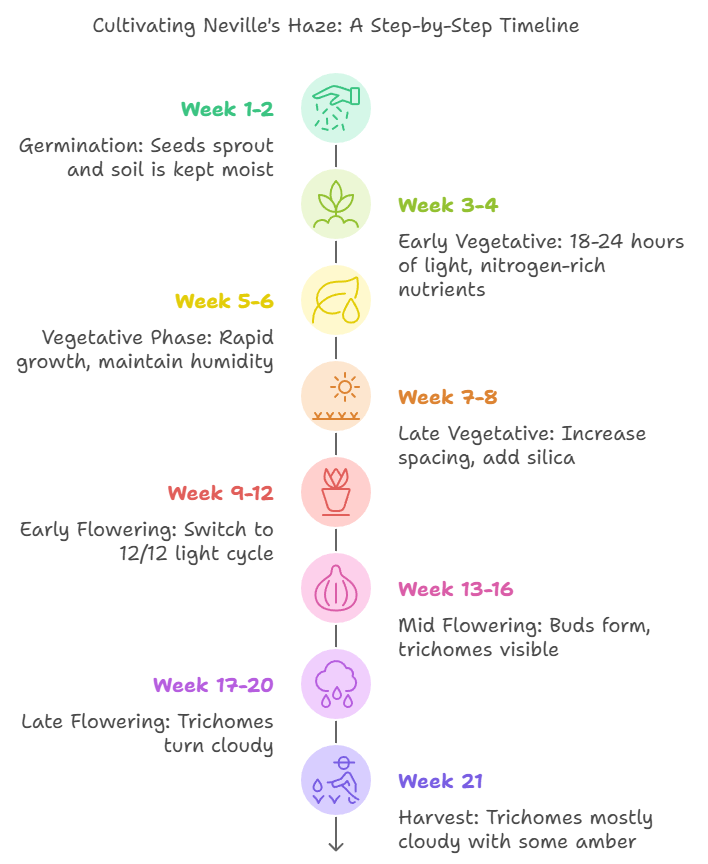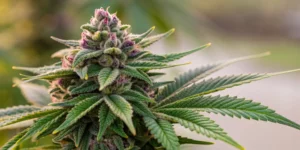Nori Cake Strain Description
The Nori Cake Strain captivates cannabis enthusiasts with its unique combination of flavors and effects. Its visually appealing buds are dense, vibrant, and covered in a frosty layer of trichomes. The aroma profile combines earthy tones, sweet nuances, and a subtle salty undertone, creating a sensory experience that sets it apart from other strains. Balancing Indica and Sativa traits, Nori Cake delivers euphoric relaxation, making it ideal for recreational use or unwinding after a long day.
Medicinal users often choose Nori Cake for its potential to alleviate stress, mild pain, and insomnia. This strain’s terpene blend enhances its calming effects while maintaining a clear-headed euphoria. Its unique flavor and effects profile make it an excellent choice for cannabis aficionados seeking something extraordinary.
Environmental Requirements for Growing Nori Cake Strain
Growing the Nori Cake Strain requires a stable environment to achieve optimal results. Indoors or outdoors, this strain thrives in temperatures between 68-80°F (20-27°C) and a relative humidity range of 40-60%. These conditions ensure healthy growth while minimizing the risk of mold and pest issues.
Adequate airflow and ventilation are essential for preventing stagnant moisture and promoting sturdy stems. Outdoors, a Mediterranean-like climate with warm days and minimal temperature drops at night provides the ideal setting for robust growth and resin production.
Setting Up the Growing Cannabis Space
Creating the ideal environment for Nori Cake cultivation begins with proper preparation of the growing space. Attention to lighting, ventilation, and substrate ensures healthy plant development.
Indoor Cannabis Cultivation
Indoor growers must provide full-spectrum LED lighting to simulate natural sunlight, optimizing photosynthesis. Keep humidity levels low during flowering to prevent mold on the dense buds. A light schedule of 18/6 during vegetative growth, transitioning to 12/12 in the flowering phase, is critical. Use nutrient-rich, well-draining soil or hydroponics for strong root systems and consistent growth.
Outdoor Cannabis Cultivation
Outdoor cultivation benefits from nutrient-dense soil and long hours of direct sunlight. Nori Cake adapts well to regions with warm, stable climates, but planting in spring ensures sufficient time for full development. Regular pruning improves airflow, enhances light penetration, and minimizes the risk of mold on its tightly packed flowers.
Propagation and Germination of Nori Cake Strain
Starting with high-quality seeds is key to successful propagation. Germination using the paper towel method ensures consistent moisture for sprouting. Alternatively, use jiffy pellets to facilitate easy transplantation. Maintain temperatures around 75°F (24°C) for reliable results.
Within 3-5 days, seeds typically sprout and develop visible roots. Once seedlings are established, transfer them to the primary growing medium to encourage early root expansion. Ensure proper care during this stage to avoid stress that may slow development.

Vegetative Phase of Nori Cake Strain
During the vegetative phase, the Nori Cake Strain focuses on developing strong roots and lush foliage. Providing consistent watering is essential, but avoid over-saturating the soil to prevent root rot. Nitrogen-rich nutrients play a crucial role in this stage, promoting vibrant green growth and preparing the plant for the next phase. Adequate light exposure and maintaining ideal temperatures of 70–80°F with humidity levels around 60–70% ensure steady vegetative development.
Good airflow is vital to prevent pest issues and strengthen stems. Training techniques like topping or low-stress training (LST) can also help control the height of Nori Cake Strain, especially in indoor setups. This encourages lateral growth, setting the stage for higher bud yields during flowering.
Flowering Phase of Nori Cake Strain
The flowering phase of Nori Cake Strain spans 8 to 10 weeks, requiring precise adjustments to environmental conditions. Lower humidity to 30–40% during this phase to avoid bud rot and other mold issues. Switching to bloom-focused fertilizers with higher phosphorus and potassium levels supports robust bud production and resin development.
Buds emit a strong, sweet aroma as they mature, making carbon filters or odor-neutralizing products a smart choice for discretion. Ensure proper airflow to prevent mold while monitoring nutrient intake closely to avoid overfeeding. Trichome development is a key indicator of readiness for harvest.
Cannabis Fertilization and Nutrition for Nori Cake Strain
Nutrient balance is vital for maximizing Nori Cake Strain’s growth and yield. In the vegetative stage, nitrogen helps the plant develop strong stems and leaves. As the plant transitions to flowering, reduce nitrogen levels while increasing phosphorus and potassium to enhance bud density and resin production.
Organic fertilizers or cannabis-specific nutrient blends are ideal for this strain, as they provide a balanced diet without causing nutrient burn. Regularly check pH levels to ensure nutrient uptake, keeping it between 6.0 and 6.5 for soil grows and 5.5 to 6.0 for hydroponic setups.
Pest and Disease Control for Nori Cake Strain
Prevention
Preventing pests during the cultivation of Nori Cake Strain starts with maintaining a clean and sterile growing environment. Proper airflow, paired with balanced watering, prevents moisture buildup that attracts pests like fungus gnats. Natural solutions like neem oil sprays act as effective preventive measures against common cannabis pests.
Using pest-resistant soil and regularly inspecting plants for early signs of infestation ensures issues are caught early. Sticky traps can help monitor flying pests, while maintaining stable environmental conditions discourages unwanted invaders.
Corrective Actions
If pests appear, immediate intervention with organic insecticides like pyrethrin or insecticidal soap is effective. Introducing beneficial insects, such as ladybugs or predatory mites, helps control pest populations naturally. Removing heavily infested leaves prevents further spread while minimizing harm to the plant.
Advantages of Growing Nori Cake Strain
The Nori Cake Strain is easy to grow and adapts well to both indoor and outdoor environments. Its natural resistance to molds and mildews simplifies pest management. With proper care, it rewards growers with high yields and a standout flavor profile.
This strain’s versatility makes it ideal for beginners and experienced cultivators alike. Its balanced hybrid effects provide a relaxing body high while maintaining mental clarity, making it suitable for various uses.
Disadvantages of Growing Nori Cake Strain
One challenge in growing Nori Cake Strain is its sensitivity to nutrient imbalances. Overfeeding can lead to nutrient burn, so monitoring and adjusting feeding schedules is crucial. Additionally, its strong aroma requires growers to use odor control methods for discretion.
Managing height in indoor grows can also pose difficulties. Regular topping or using techniques like LST helps control vertical growth, ensuring plants don’t outgrow their space.
Advanced Pest Control for Nori Cake Strain
Advanced pest control methods for Nori Cake Strain include using predator insects like ladybugs and green lacewings to combat infestations. Diatomaceous earth can deter crawling pests, while organic sprays like neem oil keep mites and aphids at bay.
Sticky traps effectively reduce flying pests such as fungus gnats. Rotating organic treatments prevents pest resistance, keeping your grow space free of infestations.
Similar Strains
If you like this strain, consider similar strains like Wedding Cake, Gelato, and Donny Burger. These strains offer comparable potency, flavors, and growth characteristics, making them good alternatives.Week-by-Week Growth Plan for Nori Cake Strain
The Nori Cake strain is known for its impressive yields and unique flavor profile, making it a favorite among cultivators. To help you get the most out of this strain, we’ve put together a detailed week-by-week growth plan that covers every phase from seedling to harvest. Follow along to ensure your Nori Cake plants thrive throughout their growth cycle.
Week 1-2: Germination and Seedling Stage
During the first two weeks, focus on germinating your Nori Cake seeds and establishing healthy seedlings.
- Germination: Start by soaking the seeds in water for 24 hours until they begin to crack open. Transfer them to a moist paper towel or directly into the growing medium.
- Lighting: Keep lighting low to moderate, using 18-24 hours of light per day.
- Humidity and Temperature: Aim for high humidity levels around 70-80%, and keep the temperature stable between 70-75°F (21-24°C).
- Watering: Avoid overwatering; keep the soil moist but not soaked to prevent damping-off disease.
Week 3-4: Early Vegetative Stage
Now that the seedlings are more stable, it’s time to encourage vigorous vegetative growth.
- Lighting: Use full-spectrum lights with a schedule of 18 hours on and 6 hours off.
- Nutrients: Begin introducing light doses of nutrients high in nitrogen to promote foliage growth.
- Humidity and Temperature: Lower humidity slightly to around 60-70% and maintain temperatures between 70-78°F (21-26°C).
- Training: Start low-stress training (LST) to manage height and encourage a more even canopy.
Week 5-6: Vegetative Growth
This phase is all about building a strong foundation for the flowering phase.
- Lighting: Maintain the same light schedule (18/6) and ensure consistent light exposure across the canopy.
- Nutrients: Increase the feeding dosage, focusing on nitrogen and adding micronutrients like magnesium and calcium.
- Training: Continue LST and, if necessary, top the plant to develop more colas.
- Watering: Increase watering frequency as the plant’s size increases, but avoid waterlogging the roots.
Week 7-8: Late Vegetative Phase
At this stage, the plants will be close to transitioning into flowering, and you’ll want to prepare them for that.
- Lighting: Maintain the light schedule (18/6) but start preparing to adjust to a 12/12 light cycle.
- Nutrients: Begin to slightly decrease nitrogen levels and start introducing more phosphorus and potassium.
- Pruning: Remove lower leaves that are not receiving much light to improve airflow and energy distribution.
- Temperature and Humidity: Drop humidity to 50-60% and maintain a temperature of 70-78°F (21-26°C).
Week 9-10: Pre-Flowering Transition
The plants will begin to stretch and show early signs of flowering.
- Light Cycle: Switch the lighting to 12 hours on and 12 hours off to initiate the flowering phase.
- Nutrients: Transition to a bloom formula, increasing phosphorus and potassium while reducing nitrogen.
- Training: Perform final adjustments in LST to manage the height and shape.
- Temperature and Humidity: Lower the humidity to 45-55% to prevent mold formation during flowering.
Week 11-12: Early Flowering
The Nori Cake strain will start to produce small buds and an increase in trichomes.
- Nutrients: Continue with bloom nutrients, focusing on phosphorus and potassium to support flower development.
- Watering: Increase the watering slightly as the buds begin to grow but avoid getting the flowers wet.
- Temperature and Humidity: Maintain temperatures between 68-75°F (20-24°C) and humidity at around 40-50%.
Week 13-14: Mid Flowering
By this point, the flowers will have bulked up considerably, and the plant will have a strong aroma.
- Lighting: Maintain the 12/12 light cycle and ensure there are no light leaks during the dark period.
- Nutrients: Keep providing bloom nutrients while adding supplements like molasses to boost microbial life and resin production.
- Air Circulation: Make sure there is sufficient airflow to avoid mold and mildew, as the buds will be denser now.
- Temperature and Humidity: Drop humidity to 35-45% to reduce the risk of mold, while maintaining temperatures around 68-75°F (20-24°C).
Week 15-16: Late Flowering
Your Nori Cake plants are almost ready for harvest, and this is when they really shine.
- Nutrients: Stop feeding with nutrients during these weeks and begin flushing with pure water to remove excess salts from the soil.
- Trichome Inspection: Use a magnifying glass to check trichome color. The ideal time to harvest is when most trichomes are cloudy with some turning amber.
- Temperature and Humidity: Keep humidity at 30-40% to avoid any mold growth, especially with the dense buds that Nori Cake produces.
Week 17-18: Ripening Phase
The final stage is all about preparing your Nori Cake strain for the best possible harvest.
- Flushing: Continue flushing with pure water. This helps improve the flavor and smoothness of the final product.
- Dark Period: Some growers give the plants 48 hours of darkness before harvesting to potentially boost resin production.
- Harvest: When the trichomes are predominantly cloudy and some are amber, it’s time to harvest your Nori Cake buds for maximum potency and flavor.
This week-by-week growth timeline provided is an estimate. Actual growth times may vary based on environmental factors such as climate and growing conditions.

FAQs About Nori Cake Strain
How much yield does Nori Cake Strain produce?
When grown under optimal conditions, Nori Cake Strain delivers impressive yields. Indoor grows typically produce 450–550 grams per square meter, while outdoor plants yield around 600 grams per plant. Proper training techniques and balanced nutrition are key to maximizing output.
What is the flavor profile of Nori Cake Strain?
Nori Cake Strain boasts a complex flavor profile combining sweet, creamy, and nutty notes with a hint of earthiness. Its unique terpene blend makes it a favorite among enthusiasts seeking a flavorful and aromatic smoking experience.
How can I improve the yield of Nori Cake Strain?
To maximize the yield of Nori Cake Strain, use training techniques like topping or low-stress training (LST) to increase bud site exposure. Provide consistent lighting, balanced nutrients, and maintain ideal environmental conditions throughout its lifecycle.
What are the medicinal benefits of Nori Cake Strain?
Nori Cake Strain offers potential relief from stress, anxiety, and mild pain due to its balanced hybrid effects. Its relaxing body high and uplifting mental buzz make it a popular choice for medicinal users seeking versatile symptom relief.
How should Nori Cake Strain be stored after curing?
Store Nori Cake Strain in airtight glass jars with humidity packs to maintain freshness and preserve its terpene profile. Keep the jars in a cool, dark place to protect the buds from light and temperature fluctuations, which can degrade potency over time.





